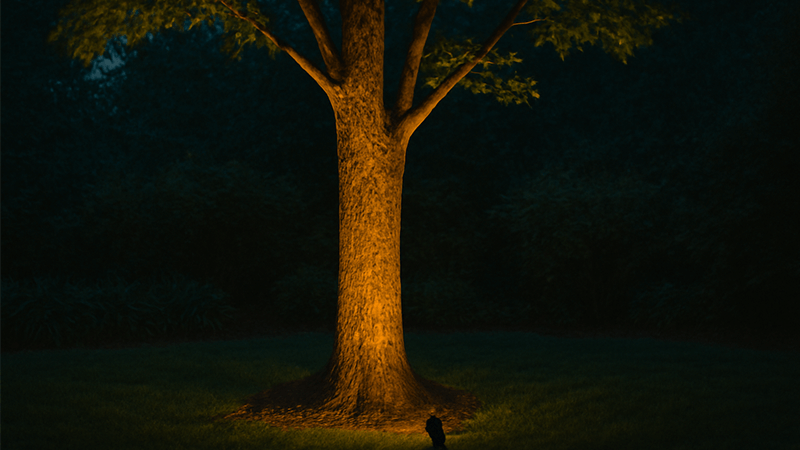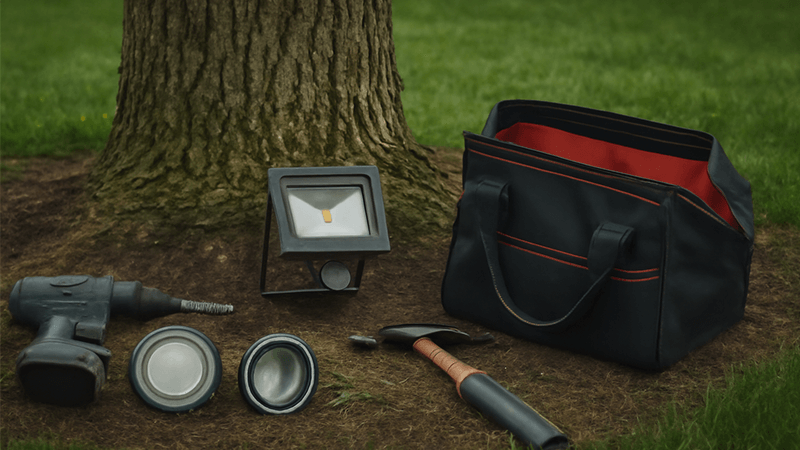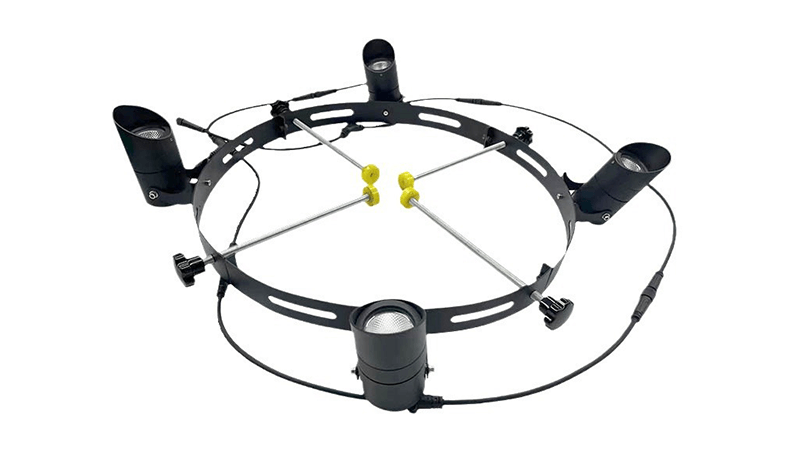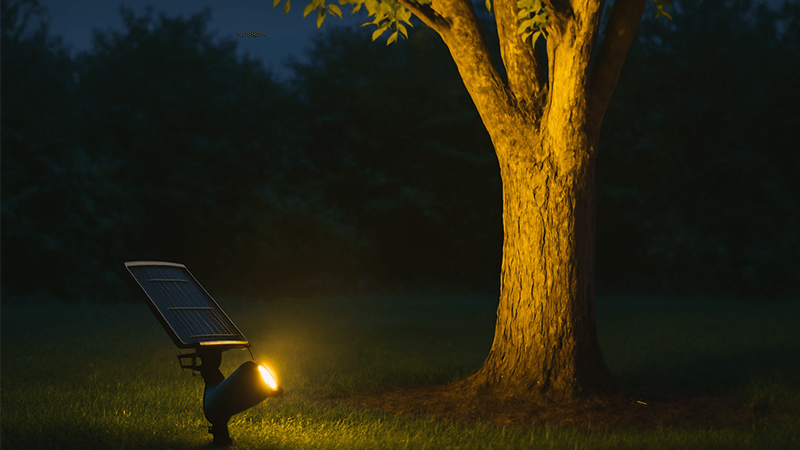Want to make your landscape stand out after dark? But unsure how to highlight your trees for that "wow" factor? Let’s explore the best ways to illuminate tree trunks beautifully.
To light up a tree trunk, use uplighting techniques with spotlights or well lights placed at its base. Angle the fixtures to graze the trunk, highlighting its unique texture and form. The key is choosing the right fixture, beam angle, and placement for a stunning, dramatic effect.

Getting that perfect look is about more than just pointing a light at a tree. The details really matter, from the type of light you choose to how you install it. Over my years in the lighting business, I’ve helped many clients like you solve these exact problems. I want to share some practical tips to make your project a success, so let’s get into the specifics.
How to put lights on a tree trunk?
Ready to install your new tree lights? But worried about damaging the tree or getting the placement wrong? Follow these simple steps for a safe and effective installation every time.
To put lights on a tree trunk, place uplights at the base, about 1-3 feet away. Angle them towards the trunk to create a grazing effect. For wrapping, use string lights, starting at the base and spiraling upwards. Always use outdoor-rated fixtures and secure cables safely.

Installing lights on a tree trunk is a straightforward process when you break it down. I always tell my clients, like Shaz, that careful planning is 90% of the job. It ensures safety and a professional-looking result. Here’s how I approach it.
Step 1: Planning and Preparation
First, decide on the effect you want. Are you aiming for a dramatic grazing effect that shows off the bark’s texture? Or a softer, more ambient glow? Your goal will determine the type of fixture and its placement. Once you have your lights, lay them out on the ground to map your design. This is also the time to gather your tools: a small shovel, wire strippers, and waterproof wire connectors. Make sure all your components, especially extension cords and fixtures, are rated for outdoor use to withstand the elements.
Step 2: Fixture Placement
For uplighting, the most common technique, you’ll place spotlights or well lights at the base of the tree. A good starting point is about 1 to 3 feet away from the trunk. For a narrow, young tree, one light might be enough. For a large, mature tree, you might need two or three fixtures placed around the base to illuminate it fully. Dig a small hole for each fixture, place it inside, and then angle it up towards the trunk. Don’t bury the wires just yet—wait until you’ve tested everything at night.
Step 3: Wiring and Safety
Safety is the most important part. When connecting the fixtures, use waterproof connectors to prevent short circuits from rain or irrigation. Run the low-voltage cable from your transformer to each light, leaving a little slack. A crucial step is to calculate the total electrical load. Add up the wattage of all the lights you plan to use. This is especially important if you are lighting many trees. LED lights are very efficient, but you must ensure the total wattage does not exceed the capacity of your transformer or circuit.
| Number of Lights |
Wattage per Light (LED) |
Total Wattage |
Recommended Transformer |
| 5 |
5W |
25W |
60W or higher |
| 10 |
5W |
50W |
100W or higher |
| 15 |
7W |
105W |
150W or higher |
Once everything is connected, turn the system on to test it. Wait until it’s dark outside to adjust the angles for the perfect effect. After you’re happy with the look, you can bury the cables a few inches underground.
What is the best way to uplight a tree?
Uplighting can completely transform a tree. But the wrong technique creates harsh glare or washes out important details. Let’s find the best approach for a stunning, professional look.
The best way to uplight a tree is to use multiple fixtures with narrow beam angles placed close to the trunk. This "grazing" technique highlights the bark’s texture. For wider canopies, add a third fixture further back with a wider beam to illuminate the branches and leaves.

As a manufacturer, I’ve seen countless lighting projects. The most successful ones always consider the unique characteristics of the tree itself. There isn’t a single "best" way, but there are proven techniques that work wonders. The goal is to enhance the tree’s natural beauty without making it look unnatural. Let’s explore the key factors for achieving a perfect uplighting effect.
Choosing the Right Angle and Distance
The relationship between the light’s angle and its distance from the trunk is everything. Placing the light very close to the base and aiming it almost straight up creates a technique called "grazing." This is perfect for trees with interesting bark, like birches or oaks, because it creates dramatic shadows that reveal the texture. For a smoother trunk, you might move the light back a bit to create a more even wash of light. The key is to experiment. I often tell my clients to test different positions at night before permanently installing the fixtures.
Balancing Intensity and Color
The brightness (lumens) and color temperature (Kelvin) of your light are just as important as placement. You want to illuminate the tree, not blast it with light. For most trees, a warm white light (around 2700K to 3000K) creates a welcoming and natural feel. Cool white light can look stark and clinical in a garden setting. Start with a lower-lumen fixture and see how it looks. It’s easier to add more light than to deal with overpowering glare. For larger trees, you will need more lumens, but balance is key.
Layering Light for Depth
For large, majestic trees, one or two lights might not be enough. This is where layering comes in. I recommend a two-layer approach for the best results:
- Trunk Illumination: Place one or two fixtures with a narrow beam (15-30 degrees) close to the trunk to graze it with light.
- Canopy Illumination: Place another fixture further back from the tree, maybe 5-8 feet, and use a wider beam spread (40-60 degrees) to light up the underside of the canopy.
This combination creates a beautiful sense of depth. It highlights the tree’s structure and its foliage, making it a true focal point in your landscape.
What kind of lights are used for uplighting?
You know you want to uplight your trees. But with so many options, which light is the right one for the job? Let’s break down the best fixtures for your project.
For uplighting, the most common lights are LED spotlights and well lights. Spotlights are versatile and easy to aim, making them great for most trees. Well lights are installed flush with the ground, offering a clean, discreet look ideal for high-traffic areas like lawns.

Choosing the right fixture is a critical decision. I always advise my partners, whether they’re distributors or contractors, that the fixture’s quality and design directly impact the final look and longevity of the project. You need something that not only provides the right kind of light but also withstands the outdoor environment. Let’s compare the main types of fixtures used for uplighting trees so you can make an informed choice.
Spotlights: The Versatile Choice
Spotlights are the go-to fixture for most uplighting applications. They are mounted on a stake or a surface mount, making them incredibly easy to install and adjust. You can easily change the angle to get the lighting just right. When I work on custom OEM designs, we focus on creating durable housings, usually from die-cast aluminum, that protect the internal electronics from water and dust. Look for spotlights with an IP rating of IP65 or higher. This ensures they can handle rain and irrigation systems without any issues. Their versatility makes them perfect for highlighting trees of all sizes.
Well Lights: The Discreet Option
Well lights are designed to be installed in-ground, so the top of the fixture is flush with the surface. This creates a very clean, professional look and is a great choice for areas where a visible fixture might be a tripping hazard, like in the middle of a lawn. The installation is more involved, as you need to dig a proper hole and often add gravel for drainage. When sourcing well lights, I emphasize the importance of a thick, durable lens that can withstand being walked on or even driven over by a lawnmower. A high IP rating, like IP67, is essential for these fixtures since they sit in the ground where water can pool.
Fixture Feature Comparison
Here’s a simple table to help you decide which fixture is right for you. I often share this with clients like Shaz to simplify their purchasing decisions.
| Feature |
LED Spotlights |
LED Well Lights |
| Installation |
Easy; stake-mounted |
More complex; requires digging |
| Adjustability |
Highly adjustable angle |
Fixed angle, less adjustable |
| Appearance |
Visible fixture |
Discreet, flush with the ground |
| Best For |
Garden beds, versatile applications |
Lawns, pathways, high-traffic areas |
| Key Consideration |
Easy to aim and reposition as tree grows |
Must have good drainage to prevent water damage |
| Typical IP Rating |
IP65 |
IP67 |
Ultimately, the best choice depends on your specific landscape and desired aesthetic. Many high-end designs use a combination of both to achieve a layered and sophisticated lighting scheme.
How to light up a tree without electricity?
Want to light a tree in a remote spot? But running electrical cables is too difficult or expensive? Solar-powered lights offer a simple, wire-free solution for beautiful illumination anywhere.
To light up a tree without electricity, use solar-powered spotlights. These fixtures have a built-in solar panel that charges a battery during the day and automatically turns the light on at night. Simply stake them in a sunny spot near the tree and aim them at the trunk.

I get this question a lot, especially from clients working on large properties or in areas where trenching for wires isn’t practical. For years, solar lighting had a reputation for being dim and unreliable. However, technology has improved dramatically. As a manufacturer, I’ve seen the evolution firsthand. Modern solar LEDs are brighter, last longer, and are more reliable than ever, making them a fantastic solution.
How Solar Uplights Work
The concept is simple but effective. Each fixture consists of an LED lamp, a small photovoltaic (solar) panel, and a rechargeable battery, all in one unit. Some models have the panel integrated into the light head, while others have a separate panel connected by a short wire. This second type is often better because you can place the panel in direct sunlight while positioning the light in the shade at the tree’s base. During the day, the panel converts sunlight into electricity and stores it in the battery. A built-in sensor detects when it gets dark and automatically switches the light on.
Advantages of Going Solar
The biggest advantage is the ease of installation. There is no wiring, no transformer, and no need to hire an electrician. You can literally place them anywhere the panel can get a few hours of direct sunlight. This makes them perfect for trees far from the house or in tricky locations. They also have zero running costs since they use the sun’s free energy. This is a great selling point for my environmentally-conscious clients. Many modern solar lights also offer impressive performance, with some high-quality models providing bright light for 8-10 hours on a full charge.
What to Look For in a Solar Light
Not all solar lights are created equal. When helping clients source products, I tell them to pay close attention to these three things:
- Battery Capacity (mAh): A higher milliamp-hour (mAh) rating means the battery can store more energy, which usually translates to a longer run time at night.
- Solar Panel Quality: Look for monocrystalline panels, which are more efficient at converting sunlight to energy compared to polycrystalline panels, especially on overcast days.
- Lumens and Durability: Check the lumen output to ensure it’s bright enough for your tree. Also, ensure the fixture is made from durable, weatherproof materials like cast aluminum and has an IP65 rating.
Here’s a quick guide:
| Feature |
Good |
Better |
Best |
| Battery |
1200mAh |
1800mAh |
2200mAh+ |
| Solar Panel |
Polycrystalline |
Monocrystalline |
High-efficiency Monocrystalline |
| Brightness |
50-100 Lumens |
100-300 Lumens |
300+ Lumens |
| Run Time |
6 hours |
8 hours |
10+ hours |
While a hardwired system will always offer more power and reliability, modern solar uplights are a brilliant and practical alternative for lighting trees without access to electricity.
Conclusion
Properly lighting a tree trunk enhances its natural beauty and adds dramatic flair to your landscape. With the right techniques and fixtures, you can create a stunning nighttime focal point.